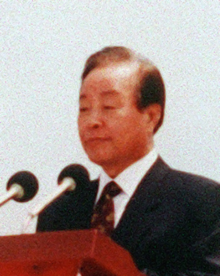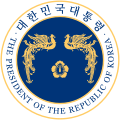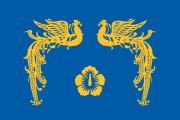Kim Young-sam
Kim Young-sam (Korean: 김영삼; Hanja: 金泳三; Korean pronunciation: [ki.mjʌŋ.sam] or [kim] [jʌŋ.sam]; 20 December 1927 – 22 November 2015) was a South Korean politician and democratic activist, who served as President of South Korea from 1993 to 1998. From 1961, he spent almost 30 years as one of the leaders of the South Korean opposition, and one of the most powerful rivals to the authoritarian regimes of Park Chung-hee and Chun Doo-hwan.
Kim Young-sam | |
|---|---|
김영삼(金泳三) | |
 | |
| 7th President of South Korea | |
| In office 25 February 1993 – 24 February 1998 | |
| Prime Minister | Hwang In-sung Lee Hoi-chang Lee Yung-dug Lee Hong-koo Lee Soo-sung Goh Kun |
| Preceded by | Roh Tae-woo |
| Succeeded by | Kim Dae-jung |
| President of the New Korea Party | |
| In office 28 August 1992 – 30 September 1997 | |
| Preceded by | Roh Tae-woo |
| Succeeded by | Lee Hoi-chang |
| President of Democratic Reunification | |
| In office 12 May 1988 – 22 January 1990 | |
| Preceded by | Kim Myung-yoon |
| Succeeded by | party merger |
| In office 1 May 1987 – 8 February 1988 | |
| Preceded by | office created |
| Succeeded by | Kim Myung-yoon |
| President of the New Democratic Party | |
| In office 7 June 1979 – 27 October 1980 | |
| Preceded by | Lee Chul-seung |
| Succeeded by | party dissolution |
| In office 21 August 1974 – 21 September 1976 | |
| Preceded by | Kim Eui-taek |
| Succeeded by | Lee Chul-seung |
| Member of the National Assembly | |
| In office 30 May 1992 – 13 October 1992 | |
| Constituency | Proportional Representation |
| In office 30 May 1988 – 29 May 1992 | |
| Constituency | Seo (Busan) |
| In office 29 July 1960 – 4 October 1979 (expelled) | |
| Constituency | Seo (Busan) |
| In office 31 May 1954 – 30 May 1958 | |
| Constituency | Geoje (South Gyeongsang) |
| Personal details | |
| Born | 20 December 1927 Geoje Island, Geoje, South Gyeongsang Province, Japanese Korea |
| Died | 22 November 2015 (aged 87) Seoul, South Korea |
| Resting place | Seoul National Cemetery, Seoul |
| Political party | Independent |
| Other political affiliations | ND (1967-1980) NKDP (1985-1987) Reunification Democratic (1987-1990) Democratic Liberal-New Korea (1990-1997) |
| Spouse(s) | |
| Children | Kim Hye-young(daughter,1952) Kim Hye-jeong(daughter,1954) Kim Eun-chul(son,1956) Kim Hyun-chul(son,1959) Kim Sang-man(extramarital son,1959) Kim Hye-sook(daughter,1961) |
| Alma mater | Seoul National University (B.A.) |
| Religion | Presbyterianism (GAPCK) |
| Signature |  |
| Military service | |
| Allegiance | |
| Branch/service | |
| Rank | Student soldier |
| Korean name | |
| Hangul | |
| Hanja | |
| Revised Romanization | Gim Yeongsam |
| McCune–Reischauer | Kim Yŏngsam |
| Pen name | |
| Hangul | |
| Hanja | |
| Revised Romanization | Geosan |
| McCune–Reischauer | Kŏsan |
Elected president in 1992, Kim became the first civilian to hold the office in over 30 years. He was inaugurated on 25 February 1993, and served a single five-year term, presiding over a massive anti-corruption campaign, the arrest of his two predecessors, and an internationalization policy called Segyehwa.
Early life and education
Kim was born in Geoje Island, by the southeastern tip of the Korean peninsula, to a rich fishing family on 20 December 1927, when Korea was under Imperial Japanese rule.[1] He was the eldest of one son and five daughters in his family.[2] During the Korean War, Kim served in the South Korean military as a student soldier (or Officer candidate). In 1952, he graduated with a Bachelor of Arts in Philosophy from Seoul National University.[3]
Career
In 1954, Kim was elected to the National Assembly of South Korea, as a member of the party led by Syngman Rhee, the first president of South Korea.[1] At the time of his election, Kim was the youngest member of the national assembly.[4] A few months after his electoral victory, Kim left his party and joined the opposition when Rhee attempted to amend the constitution of South Korea.[1] Kim then became a leading critic, along with Kim Dae-jung, of the military governments of Park Chung-hee and Chun Doo-hwan.
New Democratic Party leader
In 1974, he was elected as the president of the New Democratic Party. While he temporarily lost his power within the national assembly in 1976, Kim made a political comeback during the final year of Park Chung-hee's rule. Kim took a hardline policy of never compromising or cooperating with Park's Democratic Republican Party until the Yushin Constitution was repealed and boldly criticized Park's dictatorship, which could be punished with imprisonment under the new constitution.[5]
In August 1979, Kim allowed around 200 female workers at the Y.H. Trading Company to use the headquarters of New Democratic Party as a place for their sit-in demonstration and pledged to protect them. One thousand policemen raided the party headquarters and arrested the workers.[6] One female worker died in the process and many lawmakers trying to protect them were severely beaten, some requiring hospitalization. The YH Incident garnered widespread criticism and led to Kim's condemnation, with an assertion that Park's dictatorship would soon collapse.[7] After this incident, Park was determined to remove Kim from the political scene, like the imprisoned Kim Dae-jung, and instructed the South Korean Central Intelligence Agency (KCIA) to engineer such a move. In September 1979, a court order suspended Kim's presidency of the New Democratic Party.[8][9]
When Kim called on the United States to stop supporting Park's dictatorship in an interview with the New York Times,[8][10] Park wanted to have Kim imprisoned while the Carter Administration, concerned over increasing human right violations, issued a strong warning not to persecute members of the opposition party. When Kim was expelled from the National Assembly in October 1979, the United States recalled its ambassador back to Washington, D.C.,[7] and all 66 lawmakers of the New Democratic Party resigned from the National Assembly.[10]
When it became known that the South Korean government was planning to accept the resignations selectively, uprisings broke out in Kim's hometown of Pusan. It was the biggest demonstration since the Syngman Rhee presidency, and spread to nearby Masan and other cities, with students and citizens calling for an end to the dictatorship.[7] The crisis was one of the causes for the assassination of Park Chung-hee on 26 October 1979 by KCIA Director Kim Jae-gyu.[8]
House arrest
The government's oppressive stance towards the opposition continued under Chun Doo-hwan, who seized power with a military coup on 12 December 1979. Kim Young-Sam was expelled from the National Assembly for his democratic activities and banned from politics from 1980 to 1985. In 1983, he undertook a 21-day hunger strike protesting the dictatorship of Chun Doo-hwan.[11]
Failed presidential run: 1987
When the first democratic presidential election was held in 1987 after Chun's retirement, Kim Young-sam and Kim Dae-jung ran against each other, splitting the opposition vote and enabling ex-general Roh Tae-woo, Chun's hand-picked successor, to win the election. This was also despite support from the first female presidential candidate, Hong Sook-ja, who resigned her candidacy in order to support Kim.[12]
Merged with the ruling party: 1990-92
On January 22, 1990, he unexpectedly merged his Democratic Reunification Party with Roh's ruling Democratic Justice Party to form the Democratic Liberal Party.[5] Kim's decision angered many democratic activists but he maintained his political base in Busan and Gyeongsang. Kim chose to merge Roh's ruling party in order to become Roh's successor in 1992, which he became the presidential nominee of the ruling Democratic Liberal Party.
Presidency (1993–98)
As the candidate of the governing party,[1] he defeated Kim Dae-jung in the 1992 presidential election. He was only the third civilian to hold the office, and the first since 1962.
The Kim Young-sam administration attempted to reform the government and the economy. One of the first acts of his government was to start an anti-corruption campaign, which began at the very top, as Kim promised not to use political slush funds.[1]
Kim's government required government and military officials to publish their financial records, precipitating the resignation of several high-ranking officers and cabinet members.[13] He had his two predecessors as president, Chun and Roh, arrested and indicted on charges of corruption and treason for their role in military coups, although they would be pardoned near the end of his term.[1] Kim also granted amnesty to thousands of political prisoners, and removed the criminal convictions of pro-democracy protesters who had been arrested during the Gwangju massacre in the aftermath of the Coup d'état of December Twelfth.[13] The anti-corruption campaign was also part of an attempt to reform the chaebol, the large South Korean conglomerates which dominated the economy. However, Kim's anti-corruption message was damaged after his son was arrested for bribery and tax evasion related to the Hanbo scandal.[1]
In 1994, when American president Bill Clinton mulled over attacking Nyongbyon, the centre of North Korea's nuclear program, Kim advised him to back down to prevent renewal of fighting.[1]
Kim's new ministerial party, the DLP lost its narrow majority in the National Assembly in 1996. Kia Motors collapsed soon thereafter, setting off a chain of events which embroiled South Korea in the 1997 Asian Financial Crisis during the last year of his presidency.[13]
During the financial crisis, the collapse of Kia and other conglomerates led Kim to accept a US$58 billion bailout from the International Monetary Fund.[1]
Later life and death
After his presidency, Kim traveled the world promoting democracy, and speaking at events such as Towards a Global Forum on New Democracies in Taiwan in January 2007.[14]
He died in Seoul National University Hospital on 22 November 2015, from heart failure, at the age of 87.[1][3][15] On 26 November 2015, a televised state funeral was held for Kim at the National Assembly lawn, during which Prime Minister Hwang Kyo-ahn delivered the opening remarks.[15] Later that day, Kim was buried in the Seoul National Cemetery.[15]
Personal life
Kim was a member of the Chunghyun Presbyterian Church and was fluent in Japanese in addition to his native language, Korean. He was married to Son Myung-soon.[16] He was survived by his children, two sons and three daughters, as well as his five younger sisters.[14]
References
- Kim, Hyung-Jin. "Kim Young Sam: South Korean president ended years of military rule". The Globe and Mail. Bloomberg News. Retrieved 26 November 2015.
- "Kim Young Sam Facts". Encyclopedia of World Biography. Retrieved 12 November 2015.
- "Hospital Official: Ex-SKorean President Kim Young-Sam Dies". New York Times. Retrieved 21 November 2015.
- "Former South Korean President Kim Young-Sam Dies at 87". ABC News. Retrieved 21 November 2015.
- Breen, Michael (19 October 2011). "Kim Young-sam: the man who would be president". The Korea Times. Archived from the original on 22 November 2015. Retrieved 22 November 2015.
- Lee, Kenneth B. (1997). Korea and East Asia: The Story of a Phoenix. Westport, Conn.: Praeger. p. 196. ISBN 027595823X.
- Fowler, James (June 1999). "The United States and South Korean Democratization" (PDF). Political Science Quarterly. 114 (2): 265–288. doi:10.2307/2657739.
- Breen, Michael (15 February 2012). "Inner circle collapses: Kim Jae-gyu and Cha Ji-cheol". The Korea Times. Archived from the original on 22 November 2015. Retrieved 22 November 2015.
- Vogel, Ezra F.; Kim, Byung-Kook (2011). The Park Chung Hee Era: The Transformation of South Korea. Cambridge, Mass.: Harvard University Press. pp. 166–167. ISBN 0674058208.
- Seth, Michael J. (2010). A Concise History of Modern Korea: From the Late Nineteenth Century to the Present. Lanham: Rowman & Littlefield. p. 187. ISBN 0742567133.
- "Former President Kim Young-sam dies at age 87". The Korea Herald. 21 November 2015. Retrieved 21 November 2015.
- Holley, David (6 December 1987). "Kim Young Sam Gets Backing of Only Woman in Korea Race". Retrieved 24 November 2016.
- Kihl, Young Whan (2005). Transforming Korean Politics: Democracy, Reform, and Culture. Armonk: M.E. Sharpe. pp. 102–142. ISBN 0765614286.
- "Hospital official: Former South Korean President Kim Young-sam". Chicago Sun-Times. Retrieved 22 November 2015.
- Kim Tong-hyung (26 November 2015). "S. Koreans mourn ex-President Kim in state funeral". Associated Press. Retrieved 26 November 2015.
- Yonhap news agency Archived 30 March 2019 at the Wayback Machine. 10 March 1997.
External links
| Wikimedia Commons has media related to Kim Young-sam. |
| Wikiquote has quotations related to: Kim Young-sam |
- Kim Young-Sam Memorial Museum (in Korean)
- Kim Young-Sam, Hunjunghwe (in Korean)
- Appearances on C-SPAN
| Political offices | ||
|---|---|---|
| Preceded by Roh Tae-woo |
President of South Korea 25 February 1993 – 25 February 1998 |
Succeeded by Kim Dae-jung |

